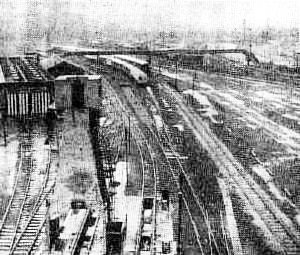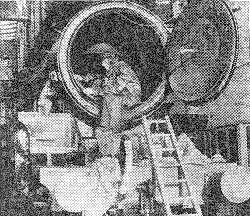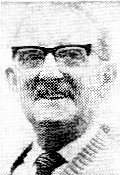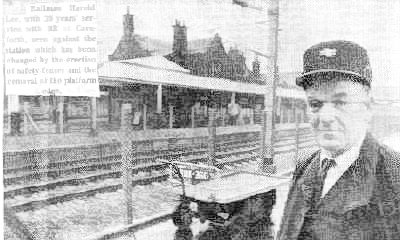|
The railwaymen of Carnforth - victims of uncertainty and change.
Victims of perpetual change, the 200 railwaymen of Carnforth still breathe in an air of uncertainty. But through the efforts of men like John Easter Roberts they still have their jobs and might even have the prospect of a brighter future. Carnforth councillors alongside union 1eaders have been fighting bitterly for the past two or three years to secure a future for the town's railwaymen. Since l969 the men of the railways have had to face a series of policy changes. The most recent downfall was the removal of the station's main line platforms. For the sake of speeding-up the trains, Carnforth is now, only open to branch line services. In jeopardy The Carnforth men also feel that if British Rail refuses to train them for electrification work their jobs will be in jeopardy. Soon the results of negotiations in London on this problem will be made known, In the meantime, there is a general concern in the town about the future. But times have not always been bad. Like many other British towns, Carnforth owes its development to the railway. In December, l846, the £l,200,000 Lancaster and Carlisle Railway was opened. Eleven years later the Ulverston and Lancaster Railway eliminated the dangerous "cross-bay" route, completed a chain of railways around the Cumbrian-coast and, most important of all, established Carnforth as an important railway junction. In 1864 a group of Manchester men formed the Carrnforth Haematite Company and large iron and steel works were built Blast furnaces, ancillary plants, Bessemer converters and slag heaps dominated the skyline. A third railway followed in 1867, linking the rapidly growing community of Carnforth with the West Riding of Yorkshire and providing the industries with yet another access for raw materials. At this time Carrnforth was one of the most important railway junctions in the North-West and three motive power depots were built to accommodate engines from three different railway companies. Skilled labour was imported from all over the country and a new township developed. For a time everything went well and the people comfortably prospered. The beginning of the end of Carnforth's prosperity came in 1929 when the ironworks were closed down and demolished. The second blow came much later, when the growth of road transport gradually took over from the railways as the most popular means of communication and Dr Beeching began making drastic rail cuts. Some anticipated a decline; and moved out, although nobody expected Carnforth's motive depot to be closed. But this came in 1969, not long after the transfer from steam to diesel. The change in traction and the closure of the depot brought about unemployment. This, the railmen thought, was the final blow, but there was more to follow.
Following the closure of the marshalling yards, there was less work for the remaining men, and the booking-on point was threatened with closure: The closure would have meant the complete elimination of the office staff and the locomotive men either by dismissal or transfer to other depots. Luckily, Carnforth Urban Council stepped in and an emergency meeting was attended by both local MPS. Mr John Downs, the divisional manager of the London Midland Region at Preston, visited Carnforth to discuss the issues, "That interview had as much to do with the retention of the booking-on point as anything," Mr Roberts, an ex-railwayman and Jus- tice of the Peace, told the Gazette. "There was a dreadful fear in the hearts of the rail- waymen that they would lose their jobs. But we finally got through... their jobs were saved." But saving the men's jobs was only step number one. "We are now trying to get the managment to train the men for electrification," said Mr Roberts. "There is no reason why the men shouldn't drive electrics," he said. Mr Jack Simpson, an engine driver at Carnforth and the local ASLEF union secretary, said: "Carnforth had alway been a Class A depot in the past, but we must forget the old days. They have gone, we must now get on the new traction. When we've gone there will be no more depot because there are no more recruits. "We were saddled with steam for too long," he added. "We were like a big depot in the last days of steam. We absorbed Tebay, Green- ayre, Oxenholme and many others. But it hit us hard when the crunch came, When we went from steam to diesel about 32 young lads went at one time" Mr Simpson stressed the importance of being allowed to work on electric traction. There's such a thing as prestige and pride in the job. We just want to take our rightful place." Mr Arnold Hammill, also an engine driver, said: "The bulk of our work is just trip jobs These can easily be knocked out." Ignored Apart from the railwaymen's need to regain some of their former importance, the towns- people also feel that British Rail have ignored them.
As John Easter Roberts wrote in his book, "The Changing Face of Carnforth "- "The lifting of the Carnforth main line platforms... was done without the knowledge or consultation of the local authority and the town and the outlying district have suffered a tremendous loss, having benefited from the main line services since the railways were laid in 1846."
Sixty-one-year-old Mr Harold Lee, who has worked at Carnforth for 39 years as a guard, shunter and signalman, said: "These platforms shouldn't have been shut. I've no idea why they did it Carnforth used to be a busy station but there's nothing now." He told how passengers travelling to Windermere from Carnforth have to go to Lancaster first. To do this they must pay for an extra 12 miles of travel. But Carnforth people retain their feeling of importance, for the town is still something of. a railway centre. Every year thousands of people visit Steamtown,.a railway museum in Carnforth's old engine sheds, formed by a group of dedicated enthusiasts who could not bear to see the final stronghold of steam demolished. Although Steamtown is much loved by the Carnforth people, who would not be without the smell of steam and the shriek of whistles, it is sad to think that Carnforth, a mere shadow of its former self, should be dominated by a museum. And although the enthusiasts are keeping the old spirit alive, the railway-- man of today sees himself drifting reluctantly into obscurity. Fortunately, Steamtown will for long serve as a reminder of the town's great and glorious past. The Westmorland Gazette, 24 th January 1975
|



